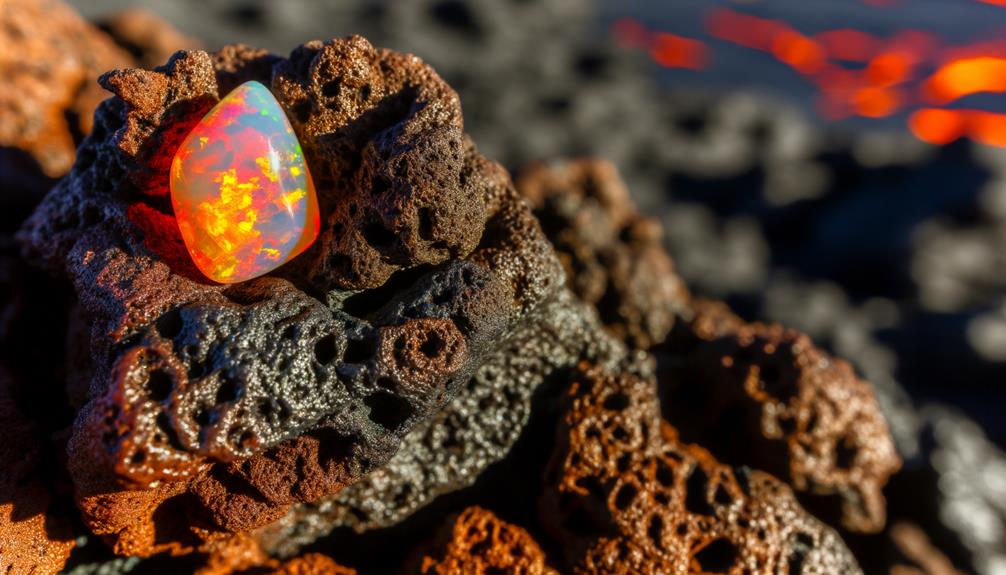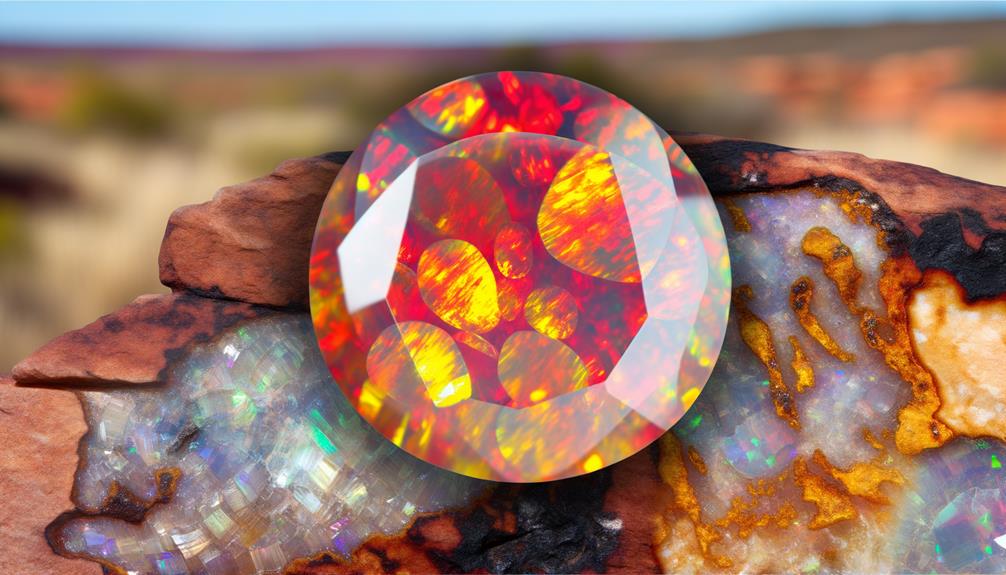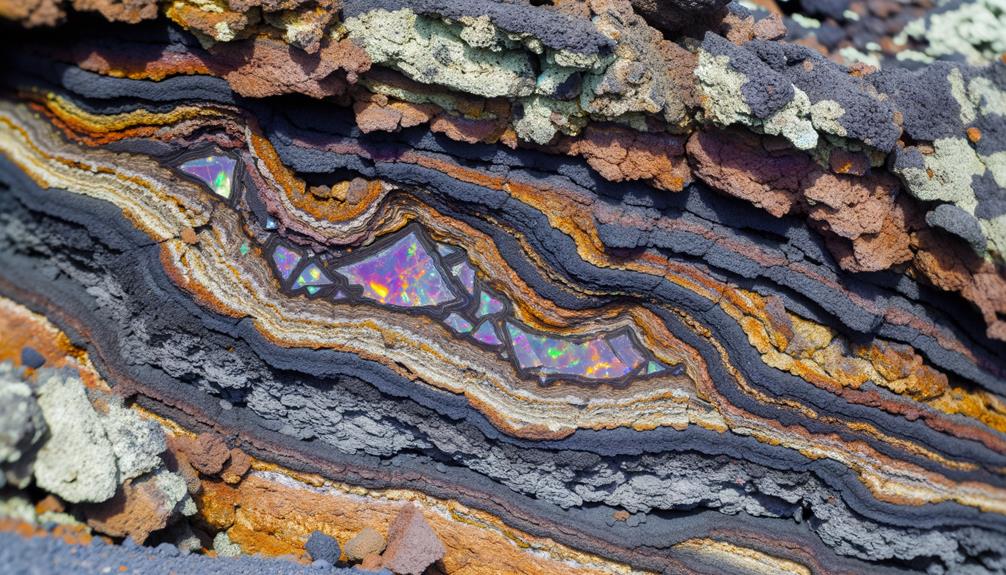How Is Fire Opal Classified: Intrusive or Extrusive?
Fire opal mostly forms in extrusive igneous rocks due to volcanic processes. Silica-rich water seeping through volcanic ash layers results in opals filling volcanic cavities.
These conditions, including rapid cooling and low-pressure environments, favor extrusive rock formations. Fire opal's vibrant colors and physical properties, with a hardness of 5.5-6.5 and specific gravity of 2.0-2.2, align with volcanic origins.
Regions like Mexico's Querétaro, where opals form in rhyolitic lava, support this extrusive nature. If you explore further, you'll uncover intricate details of fire opal's fascinating geological journey.

Key Takeaways
- Fire opals form primarily in cavities of volcanic (extrusive) rocks.
- Extrusive formations benefit from high temperatures and low pressures during crystallization.
- Fire opals can also form in fissures of deep-seated intrusive igneous formations.
- Notable occurrences of fire opals in extrusive formations are found in Mexico, Honduras, and Ethiopia.
- Formation environment influences fire opal characteristics, including color intensity and structural integrity.
Geological Formation of Fire Opal

When silica-rich water seeps into underground cavities and gradually evaporates, it leaves behind deposits that crystallize into fire opal. You'll find that these opals form under precise conditions involving temperature, pressure, and the presence of silica.
The water percolates through volcanic ash layers, carrying dissolved silica, and fills voids in the substrate. As the water evaporates, it precipitates silica spheres, which stack in a regular pattern, creating the iridescence characteristic of fire opal.
Fire opal typically has a 5.5-6.5 hardness on the Mohs scale and a specific gravity of 2.0-2.2. Understanding these parameters helps you identify the geological settings favorable for fire opal formation, aiding in both exploration and extraction processes.
Intrusive Vs. Extrusive Rocks
Fire opal, formed through specific geological processes, can be found in both intrusive and extrusive rock formations, each with distinct characteristics and formation mechanisms. Intrusive rocks, like granite, crystallize slowly beneath the Earth's surface, resulting in coarse-grained textures. Extrusive rocks, such as basalt, cool quickly at the surface, producing fine-grained textures. Understanding these differences is vital in determining the environment in which fire opal forms.
| Characteristics | Intrusive Rocks | Extrusive Rocks |
|---|---|---|
| Cooling Rate | Slow | Fast |
| Grain Size | Coarse | Fine |
| Formation Depth | Deep | Surface |
| Common Examples | Granite, Diorite | Basalt, Rhyolite |
| Crystal Size | Large | Small |
You should analyze these aspects to understand how fire opal integrates into these formations.
Characteristics of Fire Opal

You can identify fire opal by its vibrant play of colors and its unique formation within both intrusive and extrusive rock matrices. The gemstone's distinctive hues range from red, orange, and yellow, due to trace impurities like iron oxide.
Its measured refractive index lies between 1.37 and 1.52, while its specific gravity varies from 1.98 to 2.25. Fire opal's Mohs hardness rating is approximately 5.5 to 6.5, indicating moderate durability. The gemstone exhibits a vitreous to waxy luster, and its internal structure consists of hydrated silica spheres.
Analytical data reveals that fire opals can contain up to 10% water content, impacting their stability. These characteristics make fire opal a subject of interest in both geological and gemological studies.
Formation Environments
In geological terms, fire opals form in two primary environments: within the cavities of volcanic rocks (extrusive) and in the fissures of deep-seated, intrusive igneous formations.
When fire opals develop in volcanic rocks, they crystallize from silica-rich fluids in the vesicles of rapidly cooling lava. These extrusive formations benefit from high temperatures and low pressures.
On the other hand, fire opals can also form in the fissures of intrusive igneous rocks, where they're subjected to lower temperatures and higher pressures over longer periods. This environment allows for the slow deposition of silica from hydrothermal fluids.
You'll find that the geological conditions notably influence the opal's physical properties, including color intensity and structural integrity.
Examples and Occurrences

Mexico's Querétaro region is known for its abundant fire opal deposits. These gemstones are a prime example of forming in volcanic rock cavities. Fire opals in this region fill vesicles and fissures in rhyolitic lava, clearly indicating their extrusive nature.
Geological surveys have revealed that these opals originate from silica-rich fluids deposited during the cooling of volcanic rocks. Other notable occurrences of fire opals include Honduras, where they form in basalt flows, and Ethiopia's Shewa Province, where opals are found in volcanic tuffs.
Each location showcases a distinctive extrusive formation process, reinforcing the classification of fire opals. By examining these examples, one can better understand how fire opals are typically tied to extrusive igneous activities, solidifying their place in volcanic geology.
Conclusion
To conclude, fire opal primarily forms in extrusive environments, particularly within volcanic rock. Its vibrant colors and unique characteristics result from rapid cooling and high silica content.
For example, in Mexico's Querétaro region, extensive volcanic activity has led to the formation of these beautiful gemstones.
Understanding the geological processes behind fire opal's formation not only enhances our appreciation but also aids in targeted exploration and extraction, maximizing both scientific knowledge and economic benefits.






